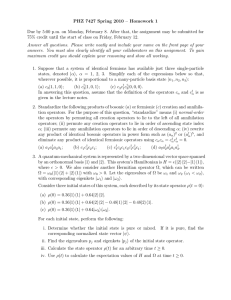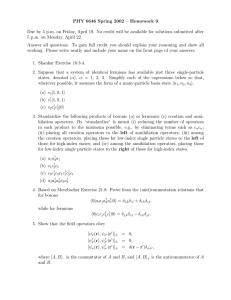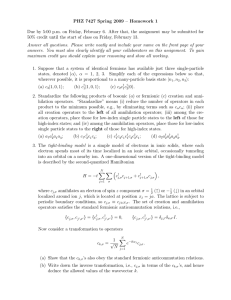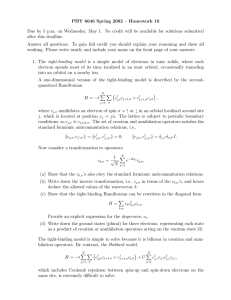XI. ELECTRODYNAMICS OF MEDIA
advertisement
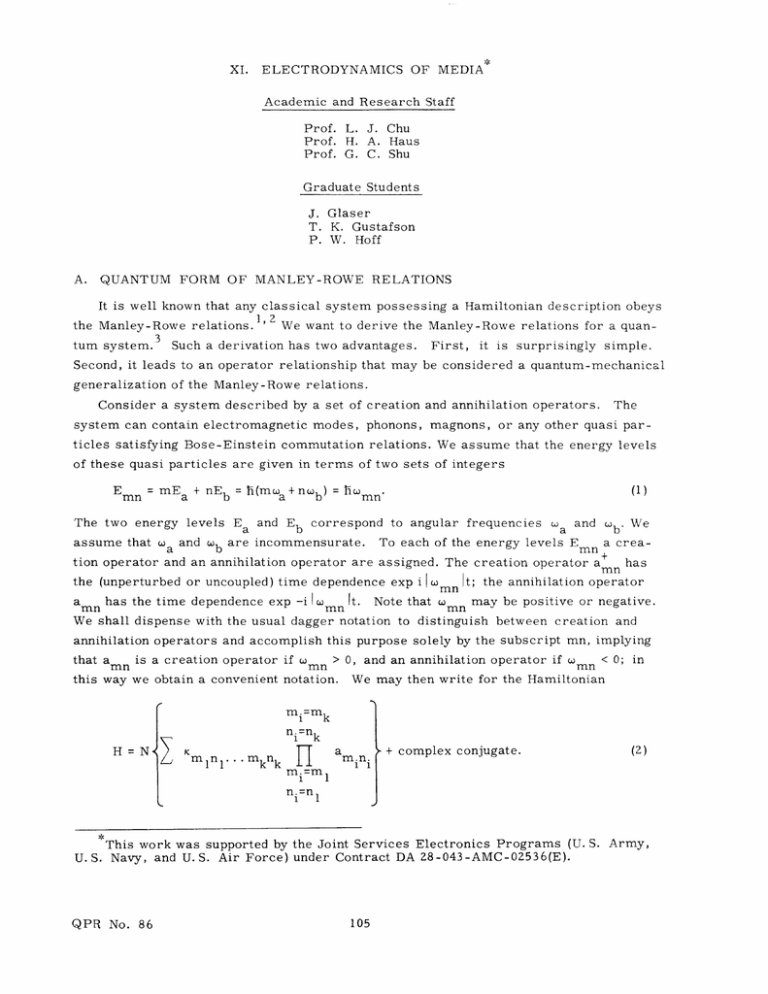
XI.
ELECTRODYNAMICS
OF MEDIA
Academic and Research Staff
Prof. L. J. Chu
Prof. H. A. Haus
Prof. G. C. Shu
Graduate Students
J. Glaser
T. K. Gustafson
P. W. Hoff
A.
QUANTUM FORM OF MANLEY-ROWE
RELATIONS
It is well known that any classical system possessing a Hamiltonian description obeys
the Manley-Rowe relations.1, 2 We want to derive the Manley-Rowe relations for a quantum system.3
Such a derivation has two advantages.
First,
it
is
surprisingly simple.
Second, it leads to an operator relationship that may be considered a quantum-mechanical
generalization of the Manley-Rowe relations.
Consider a system described by a set of creation and annihilation operators.
system can contain electromagnetic modes, phonons,
The
magnons, or any other quasi par-
ticles satisfying Bose-Einstein commutation relations. We assume that the energy levels
of these quasi particles are given in terms of two sets of integers
Emn = mE
=
+ nE
=
h(mwa + nb)
mn(1)
The two energy levels Ea and Eb correspond to angular frequencies
assume that
Coa
and wb are incommensurate.
woa and o b . We
To each of the energy levels Emn a crea-
tion operator and an annihilation operator are assigned. The creation operator a
+
has
mn
the (unperturbed or uncoupled) time dependence exp i Wmn t; the annihilation operator
mn may be positive or negative.
a mn has the time dependence exp -i Iwmn It. Note that mn
We shall dispense with the usual dagger notation to distinguish between creation and
annihilation operators and accomplish this purpose solely by the subscript mn, implying
< 0; in
that a mn is a creation operator if w mn > 0, and an annihilation operator if w mn
mn
this way we obtain a convenient notation. We may then write for the Hamiltonian
mi =mk
n.=nk
H = N
K
..
mkk
•1"mknk
m
=
m.=m
1
1
n.=n
1
am
mmn.
+ complex conjugate.
(2)
1
This work was supported by the Joint Services Electronics Programs (U. S. Army,
U.S. Navy, and U.S. Air Force) under Contract DA 28-043-AMC-02536(E).
QPR No. 86
105
OF MEDIA)
ELECTRODYNAMICS
(XI.
... mk, n
The sum is carried over all permissible combinations m
1
nk that ensure
...
time independence of H, so that
k
k
m
(3)
n. = 0.
= 0
i=l
i=l
Furthermore, the sum extends over all orders k higher than first.
The symbol N{
}
All creation operators are implied to precede the annihila-
indicates normal ordering.
There is no restriction against repetition of particular m i or n. values.
tion operators.
In particular, am.n. may occur several times as a factor in any one of the terms in (2).
J j
The leading term for k = 2 has the coefficient
K
lnlm(=-ml) n 2 (=-n
I
) =Ih
1
lnl
because this is the self-term giving the energy of the mln
1
level.
The operators amn obey the following commutation relations:
m.
(4)
6
,a-m -n
.
an.-
nm.n.)
(4)
m.m. n.n.
The commutator vanishes unless m. 1 = m.
J
n. = n., and is negative if
1
then a m In. is a creation operator; positive if
< 0,
m.
1 1
since then a
1 1
m
11
m.n.
> 0,
since
is an annihila-
11
One expects that the quantum generalization of the Manley-Rowe relations
tion operator.
would take the form
0C
I
N (a
m. sgn
1
dt
tmn
a
mn
-m.-n.=
(5)
0.
1
n.=-o
1
n i sgn
i
c
Wm.n
)
a
mn
dt
m
-m-n
(6)
= 0.
1
n.=-oo
In order to prove (5) and (6),
one needs the equations of motion for the operators, which
are
(7)
ihamn = [amn, H].
Now
consider the
QPR No. 86
contribution
to
(5)
of one
106
particular
term
in
the Hamiltonian
(XI.
ELECTRODYNAMICS OF MEDIA)
when one forms
1 [a m
n
, H] a_mn +
a
[am-n' H],
and operates on one typical term as displayed in (2), one gets k contributions. Assuming
at the outset that none of the operators occur to a power higher than first, we have
k
i
m sgn
h i=
mini
Kmknka
m
mn
. anmknk
n
mln 1
(8)
mk k(
But by virtue of the fact that sgn (w
) = 1, and by virtue of (3), one finds that the conmn
tribution is zero. This procedure needs to be modified only slightly if an operator
a -m.-n. enters the product to higher order than first, say to qith order. In such a case,
minm ,aa --.
=
-
i
-qi sgn
m
ai
a
-m.-n.'
Thus one gets a contribution, qimi . Since one of the relationships (3), when repetitions
of the m occur, can be interpreted to mean
qimi = 0,
and the summation is only over nonrepeated occurrences of the operators, one still concludes that the term (8) sums to zero. With this, (5) is proved, and a similar procedure
proves (6).
Note that (5) and (6) contain operators and not expectation values, and in
this sense are true quantum-mechanical generalizations.
An analogous proof can be conducted for a system described in terms of FermiDirac creation and annihilation operators obeying anti-commutation relations, provided
one requires that the Fermi-Dirac particles are conserved in number. This means that
the Hamiltonian must contain solely even-order terms, each of which contains an equal
number of creation and annihilation operators. Clearly, the time independence of the
Hamiltonian requires that the sum of the energies of the energy levels represented by
the creation operators must be equal to that of the annihilation operators. The ManleyRowe relations obeyed by such a system are of the form of (5) and (6),
operators a
and a
are now Fermi-Dirac operators.
1
1
1
except that the
1
Finally, one can look at a combined system with a Hamiltonian containing products
of Bose-Einstein and Fermi-Dirac operators. The proof that such a system obeys
Manley-Rowe relations of the form (5) and (6) is a straightforward extension.
QPR No. 86
107
(XI.
ELECTRODYNAMICS OF MEDIA)
The author wishes to acknowledge useful discussions with Dr. P.
Mr. T.
K. Gustafson.
L. Kelley and
In particular, Dr. Kelley suggested the approach using second
quantization.
H. A. Haus
References
1. J. M. Manley and H. E. Rowe, "Some General Properties of Nonlinear Elements.
I. General Energy Relations," Proc. IRE 44, 904-913 (1956).
2.
P. Penfield, Jr., Frequency-Power Formulas (The M. I. T. Press, Cambridge, Mass.,
and John Wiley and Sons, Inc., New York, 1960).
3.
A. E. Siegman, "Obtaining the Equations of Motion for Parametrically Coupled
Oscillators or Waves," Proc. IEEE 54, 756-762 (1966).
QPR No. 86
108
